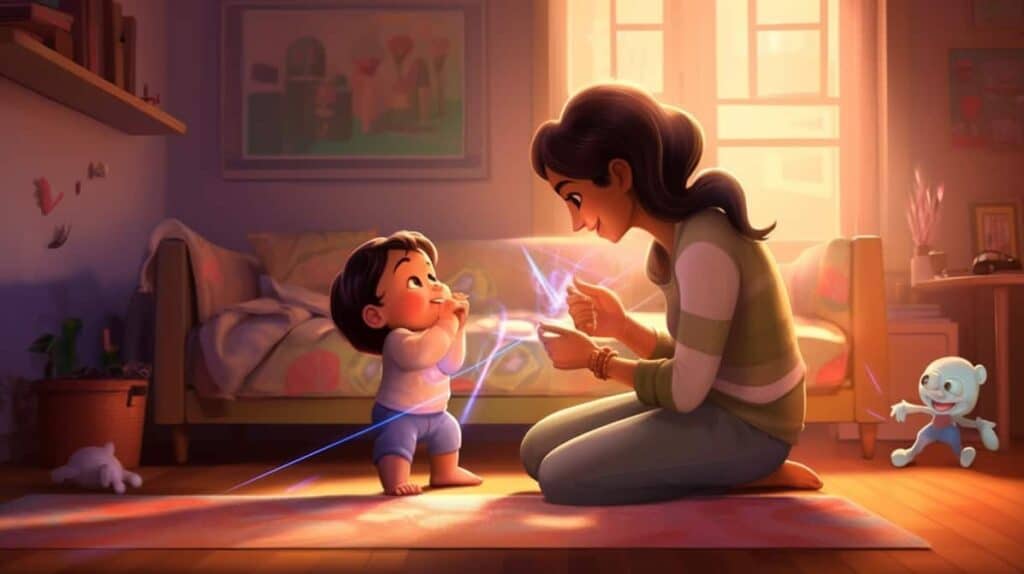Oh, parenthood! A journey full of joy, wonder, but also endless questions:
- “Is my child eating enough? »,
- "Why doesn't he stop crying?" »,
- "What does that look mean?" »…
Today, we are going to focus on this last question, by approaching the vast field of non-verbal communication.
The Evolution of Non-Verbal Communication With Age
Children are not only born communicators, but they are also excellent learners. There non-verbal communication of your child will grow and develop as they grow and learn.
Babies
Babies have a limited repertoire of non-verbal communication, mostly based on their crying and body movement. Crying can indicate hunger, the need for a diaper change, or just the desire for a warm hug.
Toddlers
As your child grows and develops their motor skills, their non-verbal communication will also grow. Toddlers begin to use deliberate gestures, such as pointing, and their body language will become more complex.
Preschoolers
At preschool age, children begin to understand that their behavior has a impact on others. They may begin to use non-verbal communication to manipulate situations to their advantage (we all know the hang-dog stare to get what they want, right?).
school children
As children grow and begin to attend school, their understanding of non-verbal communication becomes more nuanced. They begin to understand that the tone of voice, the eye contact and the facial expressions can change the meaning of their words.
This knowledge of the evolution of nonverbal communication can help parents adapt their responses and better understand their child at each stage of their development. development. So the journey of parenthood can become a little less confusing and a whole lot more rewarding!

Understanding Non-Verbal Communication In Children
Every parent knows that children are incredibly expressive creatures, even before they start talking. Their faces, gestures, and even their tears are all means of communication. These manifestations, which we classify as non-verbal communication, can help us understand their needs and emotions.
Types of Non-Verbal Communication
Nonverbal communication falls into several categories:
- THE Facial expressions : Is your child smiling broadly or frowning? These expressions can indicate feelings of joy or frustration.
- THE Body language : A child who snuggles up may need reassurance, while another who stands up straight and looks away may feel upset.
- THE Gestures : Hand or arm gestures can be an early form of language.
- THE Eye Contact : A steady gaze may indicate interest or a demand for attention.
- THE Tears and the Sounds : Different types of crying can mean different things. For example, a loud, high-pitched cry may indicate pain, while a weak, moaning cry may signify fatigue.
| Type of Communication | Description | Example |
|---|---|---|
| Facial expressions | Emotions expressed by the face | Smile, frown |
| Body language | posture and body movements | Snuggle up, look away |
| Gestures | Hand or arm movements | show, point |
| Eye Contact | The intensity and duration of the gaze | Look directly, avoid looking |
| Cries and Sounds | The different types of sounds produced | cry loudly, moan |

How to Respond to Non-Verbal Communication
Now that we have deciphered these nonverbal cues, what do we do? Here are some tips for responding effectively to your child's nonverbal communication:
- Listen with your eyes : Pay attention to your child's non-verbal signals and try to understand what he is trying to communicate.
- Respond with empathy : Acknowledging your child's emotions can help them feel understood.
- Encourage expression : Encourage your child to use gestures and expressions to communicate.
Mistakes to avoid
- Ignore non-verbal cues: If your child starts crying or fidgeting, he's probably trying to tell you something.
- Overreacting: It is important to remain calm and understanding when dealing with your child's emotions.
- Not encouraging expression: Let your child express their feelings freely.

Non-Verbal Communication and Education
Finally, it is important to note that non-verbal communication can also play a crucial role in your child's education. As parents, we are often role models for our children, and they learn a lot from our own nonverbal behaviors. Therefore, try to be aware of your own non-verbal cues when interacting with your child.
In conclusion, understanding non-verbal communication can greatly improve your relationship with your child and make parenting easier. So the next time your little angel gives you a puzzled look, remember: it's not you, it's him trying to tell you something!
Here is a quick cheat sheet to help you become a pro at non-verbal communication:
- Listen with your eyes and pay attention to your child's non-verbal cues.
- Respond with empathy and recognize emotions of your child.
- Encourage your child to use gestures and expressions to communicate.
- Be aware of your own nonverbal cues when interacting with your child.
Remember, parenthood is an adventure, not a destination. So enjoy the journey, even if sometimes you have to translate your child's non-verbal language along the way!
